1998 CHEVROLET VENTURE tire type
[x] Cancel search: tire typePage 268 of 474
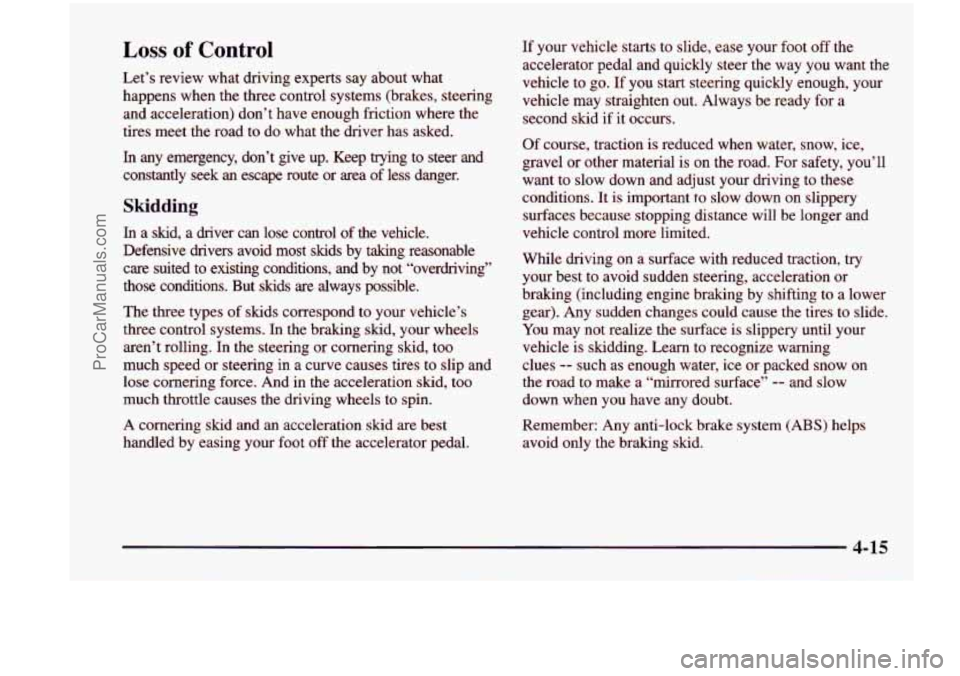
Loss of Control
Let’s review what driving experts say about what
happens when the three control systems (brakes, steering
and acceleration) don’t have enough friction where the
tires meet the road to do what the driver has asked.
In any emergency, don’t give up. Keep trying to steer and
constantly seek
an escape route or area of less danger.
Skidding
In a skid, a driver can lose control of the vehicle.
Defensive drivers avoid most skids by taking reasonable
care suited to existing conditions, and by not “overdriving”\
those conditions. But skids are always possible.
The three types of skids correspond to your vehicle’s
three control systems. In the braking skid, your wheels
aren’t rolling. In the steering
or cornering skid, too
much speed or steering in a curve causes tires to slip and
lose cornering force. And in the acceleration skid, too
much throttle causes the driving wheels
to spin.
A cornering
skid and an acceleration skid are best
handled by easing your foot
off the accelerator pedal. If
your vehicle starts to slide, ease your foot off the
accelerator pedal and quickly steer the way you want the
vehicle to go.
If you start steering quickly enough, your
vehicle may straighten out. Always be ready for a
second skid if it occurs.
Of course, traction is reduced when water, snow, ice,
gravel or other material is on the road. For safety, you’ll\
want to slow down and adjust your driving to these
conditions. It is important
to slow down on slippery
surfaces because stopping distance will be longer and
vehicle control more limited.
While driving on a surface with reduced traction,
try
your best to avoid sudden steering, acceleration or
braking (including engine braking by shifting to a lower
gear). Any sudden changes could cause the tires to slide.
You may not realize the surface is slippery until your
vehicle is skidding. Learn to recognize warning
clues
-- such as enough water, ice or packed snow on
the road to make a “mirrored surface” -- and slow
down when you have any doubt.
Remember: Any anti-lock brake system
(ABS) helps
avoid only the braking skid.
ProCarManuals.com
Page 289 of 474
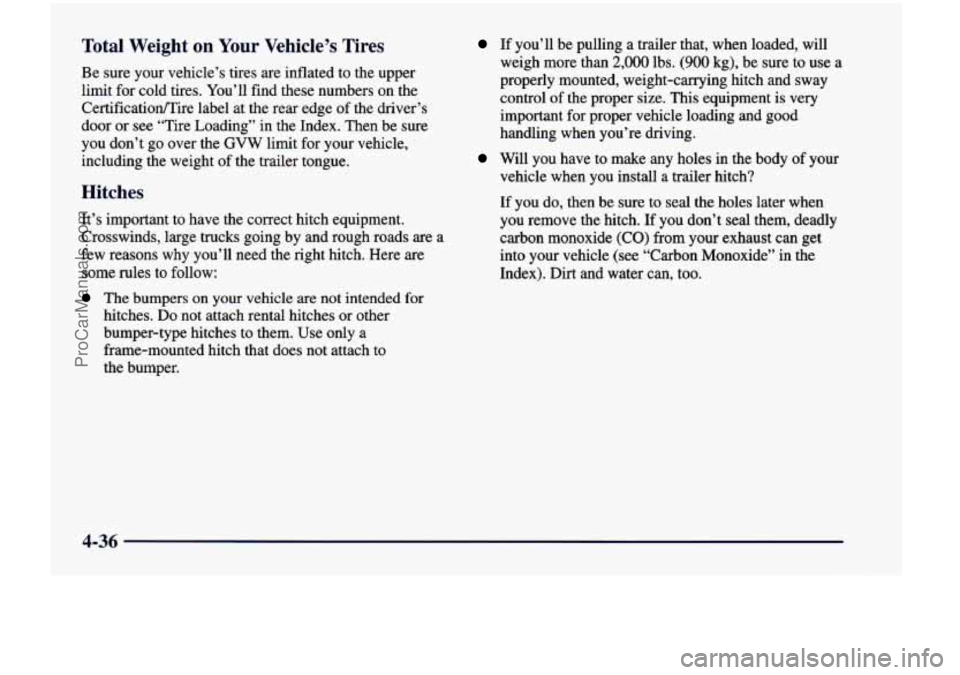
Total Weight on Your Vehicle’s Tires
Be sure your vehicle’s tires are inflated to the upper
limit for cold tires. You’ll find these numbers on the
Certificatioflire label at the rear edge of the driver’s
door or see “Tire Loading” in the Index. Then be sure
you don’t go over the GVW
limit for your vehicle,
including the weight of the trailer tongue.
Hitches
It’s important to have the correct hitch equipment.
Crosswinds, large trucks going by and rough roads are a
few reasons
why you’ll need the right hitch. Here are
some rules to follow:
If you’ll be pulling a trailer that, when loaded, will
weigh more than
2,000 lbs. (900 kg), be sure to use a
properly mounted, weight-carrying hitch and sway
control of the proper size. This equipment is
very
important for proper vehicle loading and good
handling when you’re driving.
Will you have to make any holes in the body of your
vehicle when you install a trailer hitch?
If you do, then be sure to seal the holes later when
you remove the hitch. If you don’t seal them, deadly
carbon monoxide
(CO) from your exhaust can get
into your vehicle (see “Carbon Monoxide” in the
Index). Dirt and water
can, too.
The bumpers on your vehicle are not intended for
hitches.
Do not attach rental hitches or other
bumper-type hitches to them. Use only a
frame-mounted hitch that does not attach to
the bumper.
4-36
ProCarManuals.com
Page 305 of 474
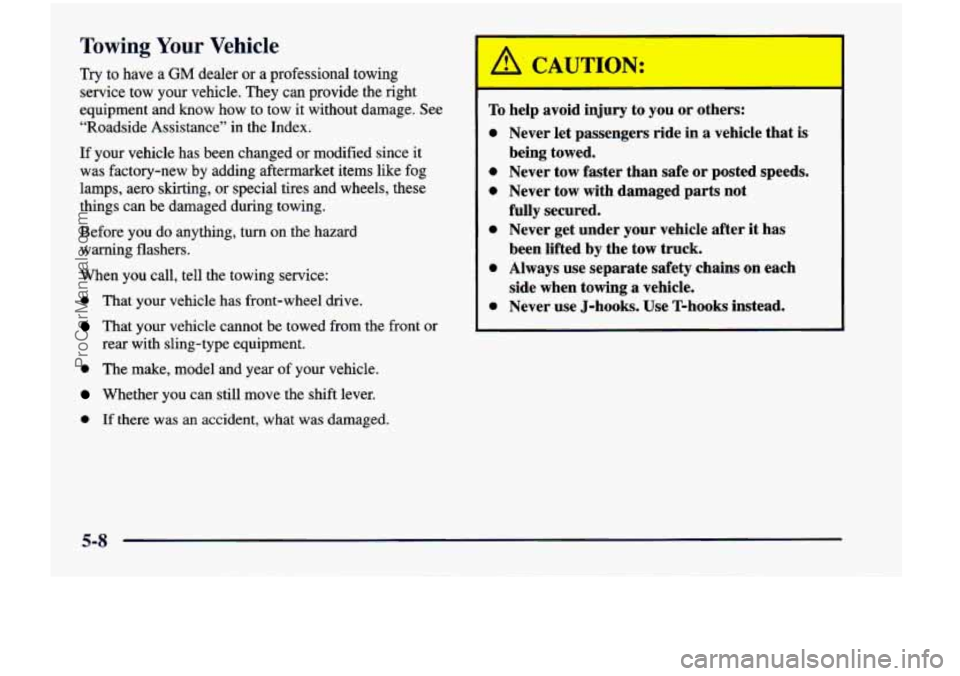
Towing Your Vehicle
Try to have a GM dealer or a professional towing
service tow your vehicle. They can provide the right
equipment and know how to tow it without damage. See
“Roadside Assistance” in the Index.
If your vehicle has been changed or modified since it
was factory-new
by adding aftermarket items like fog
lamps, aero skirting,
or special tires and wheels, these
things can be damaged during towing.
Before you do anything, turn on the hazard
warning flashers.
When you call, tell
the towing service:
0 That your vehicle has front-wheel drive.
That your vehicle cannot be towed from the front or
0 The make, model and year of your vehicle.
Wether you can still move the shift lever.
0 If there was an accident, what was damaged.
rear with sling-type
equipment.
To
0
0
e
0
0
0
help avoid
injury to you or others:
Never let passengers ride in a vehicle that is
being towed.
Never tow faster than safe
or posted speeds.
Never tow with damaged parts not
fully secured.
Never get under your vehicle after it has
been lifted by the tow truck.
Always use separate safety chains on each
side when towing a vehicle.
Never use J-hooks. Use T-hooks instead.
5-8
ProCarManuals.com
Page 376 of 474
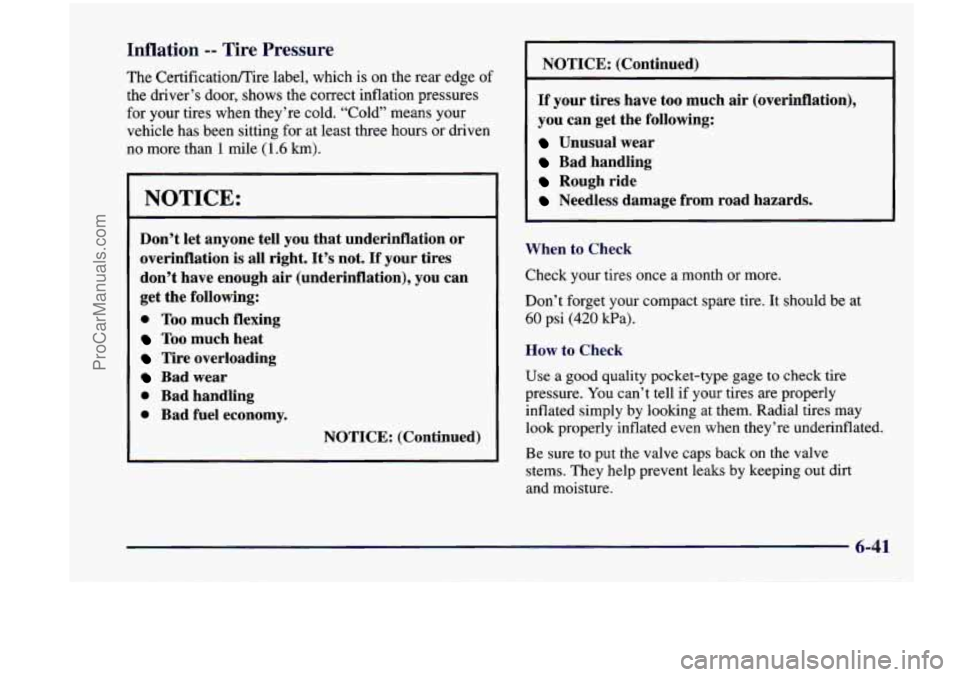
Inflation -- Tire Pressure
The Certificatioflire label, which is on the rear edge of
the driver’s door, shows the correct inflation pressures
for your tires when they’re cold. “Cold” means your
vehicle has been sitting for at least three hours or driven
no more than 1 mile (1.6 km).
NOTICE:
Don’t let anyone tell you that underinflation or
overinflation is all right. It’s not. If your tires
don’t have enough air (underinflation), you can
get the following:
0 Too much flexing
Too much heat
Tire overloading
Bad wear
0 Bad handling
0 Bad fuel economy.
NOTICE: (Continued) NOTICE: (Continued)
If your tires have too much
air (overinflation),
you can get the following:
Unusual wear
Bad handling
Rough ride
Needless damage from road hazards.
When to Check
Check your tires once a month or more.
Don’t forget your compact spare tire. It should be at
60 psi (420 kPa).
How to Check
Use
a good quality pocket-type gage to check tire
pressure. You can’t tell if your tires are properly
inflated simply by looking
at them. Radial tires may
look properly inflated even when they’re underinflated.
Be sure
to put the valve caps back on the valve
stems. They help prevent leaks by keeping out dirt
and moisture.
6-41
ProCarManuals.com
Page 378 of 474
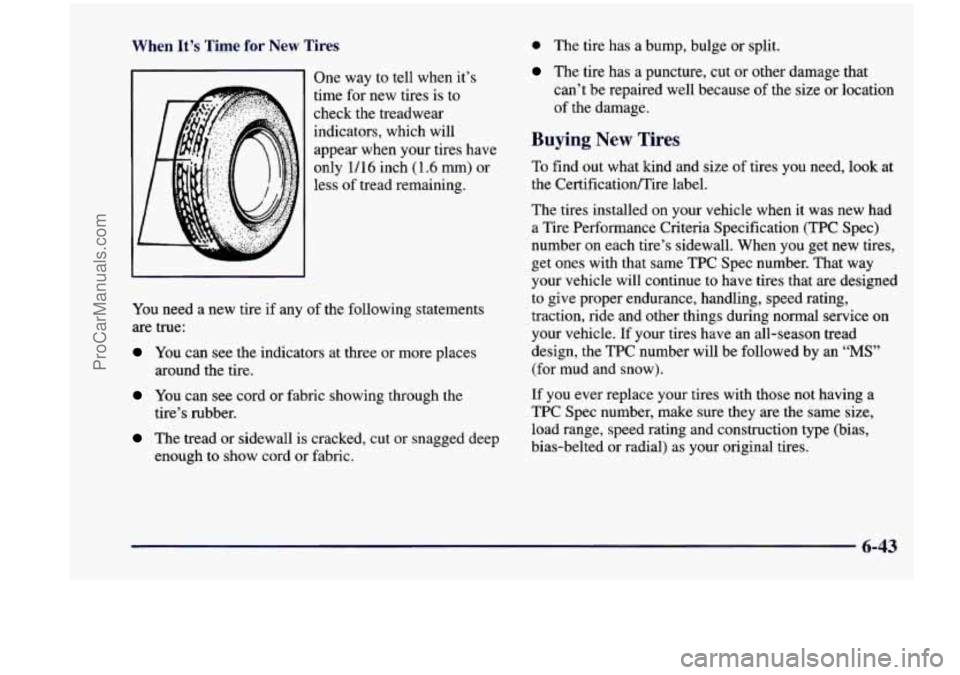
When It’s Time for New Tires
11 One way to tell when it’s
time for new tires is to
check the treadwear
indicators, which will
appear when your tires have
only
1/16 inch (1.6 mm) or
less
of tread remaining.
0 The tire has a bump, bulge or split.
The tire has a puncture, cut or other damage that
can’t be repaired well because of the size or location
of the damage.
Buying New Tires
To find out what kind and size of tires you need, look at
the Certificatioflire label.
You need a new tire if any
of the following statements
are true:
You can see the indicators at three or more places
around the tire.
You can see cord or fabric showing through the
tire’s rubber.
The tread or sidewall is cracked, cut or snagged deep
enough
to show cord or fabric. The
tires installed on your vehicle when it was new had
a Tire Performance Criteria Specification (TPC Spec)
number on each tire’s sidewall. When you get new tires,
get ones with that same TPC Spec number. That way
your vehicle will continue to have tires that
are designed
to give proper endurance, handling, speed rating,
traction, ride and other things during normal service on
your vehicle. If your tires have an all-season tread
design, the TPC number will be followed by an
“MS”
(for mud and snow).
If you ever replace your tires with those not having
a
TPC Spec number, make sure they are the same size,
load range, speed rating and construction type (bias,
bias-belted or radial) as your original tires.
ProCarManuals.com
Page 379 of 474
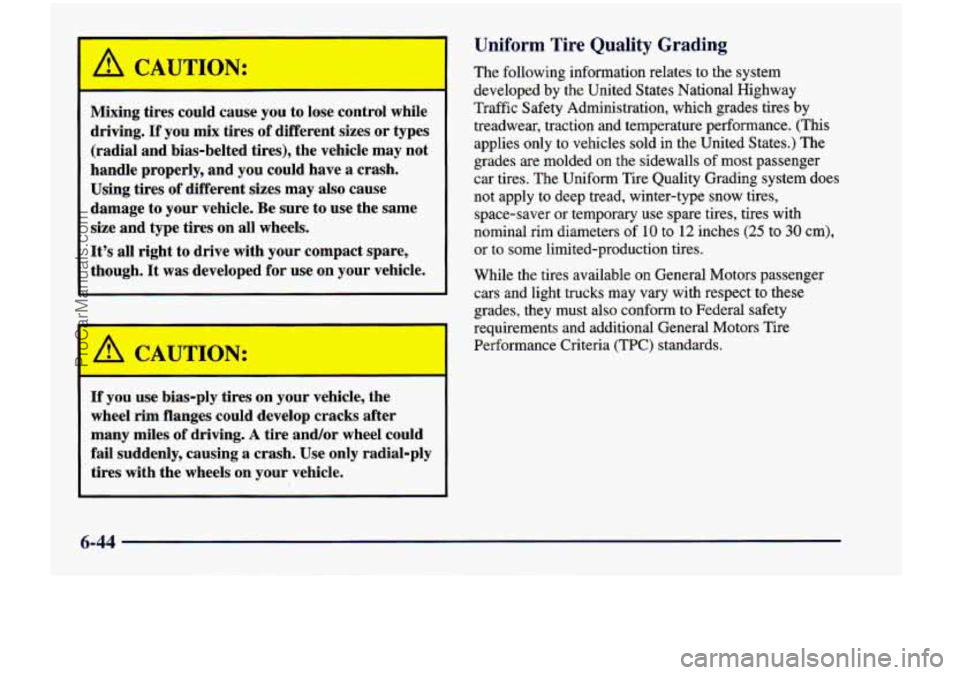
Mixing tires could cause you to lose control while
driving.
If you mix tires of different sizes or types
(radial and bias-belted tires), the vehicle may not
handle properly, and you could have a crash.
Using tires
of different sizes may also cause
damage to your vehicle. Be sure to use the same
size and type tires on all wheels.
It’s all right to drive with your compact spare,
though. It was developed
for use on your vehicle.
If you use bias-ply tires on your vehicle, the
wheel rim flanges could develop cracks after
many miles
of driving. A tire and/or wheel could
fail suddenly, causing
a crash. Use only radial-ply
tires with the wheels
on your vehicle.
Uniform Tire Quality Grading
The following information relates to the system
developed by the United States National Highway
Traffic Safety Administration, which grades tires
by
treadwear, traction and temperature performance. (This
applies only to vehicles sold in the United States.) The
grades are molded on
the sidewalls of most passenger
car tires. The Uniform Tire Quality Grading system does
not apply to deep tread, winter-type snow tires,
space-saver
or temporary use spare tires, tires with
nominal rim diameters
of 10 to 12 inches (25 to 30 cm),
or to some limited-production tires.
While the tires available
on General Motors passenger
cars and light trucks may vary with respect to these
grades, they must also conform to Federal safety
requirements and additional General Motors Tire
Performance Criteria (TPC) standards.
6-44
ProCarManuals.com
Page 382 of 474

~
~ 1 Tire Chains
NOTICE:
The wrong wheel can also cause problems with
bearing life, brake cooling, speedometer or
odometer calibration, headlamp aim, bumper
height, vehicle ground clearance and tire or tire
chain clearance to the body and chassis.
See “Changing a Flat Tire” in the Index for
more information.
Putting
a used wheel on your vehicle is
dangerous. You can’t know how it’s been used or
how
far it’s been driven. It could fail suddenly
and cause an accident.
If you have to replace a
wheel, use a new GM original equipment wheel.
NOTICE:
Use tire chains only where legal and only when
you must. Use only
SAE Class “S” type chains
that are the proper size for your tires. Install
them on the front tires and tighten them
as
tightly as possible with the ends securely
fastened. Drive slowly and follow the chain
manufacturer’s instructions.
If you can hear the
chains contacting your vehicle, stop and retighten
them.
If the contact continues, slow down until it
stops. Driving
too fast or spinning the wheels
with chains on will damage your vehicle.
6-47
ProCarManuals.com
Page 390 of 474

Appearance Care Materials Chart
PART NUMBER I SIZE
994954 I 23 in. x 25 in.
1050172 I 16 02. (0.473 L)
~~~~ ~~
1050173 16
oz. (0.473 L) 1052870 23
oz. (0.680 L) 1050427 32
oz. (0.946 L) 1050214
16
oz. (0.473 L) 1050174 16
02. (0.473 L)
DESCRIPTION
Exterior
polishing cloth
Polishing Cloth - Wax
Treated
USAGE
Tar and Road Oil Remover
Use on chrome, stainless steel, nickel, copper and brass
Chrome Cleaner and Polish Removes
tar, road oil and asphalt
Removes soil and black marks from whitewalls
White Sidewall Tire Cleaner
Vinyl Cleaner
Glass Cleaner Cleans vinyl tops,
upholstery and convertible tops
Removes dirt, grime, smoke and fingerprints
Wash Wax Concentrate Cleans and lightly waxes
1052918”” I 8 oz. (0.237 L) Armor All Protectant Protects
leather, wood, acrylics, Plexiglas TM , plastic,
rubber and vinyl
1052925 I 16 oz. (0.473 L) I
Multi-Purpose Interior
Cleans carpets, seats, interior trim, door panels
Cleaner and
floor mats I
1052929 I 16 oz. (0.473 L) I Wheel Cleaner I Spray on and rinse with water
1052930
Spray on tire shine
Silicone Tire Shine 12 02. (0.354 L) 12345725
Shines
vehicle without scratching
Synthetic Chamois 2.5 sq. ft. 12345721
Cleans and
shines a variety of surface types
Armor
All TM Cleaner 16 oz. (0.473 L) 12345002
Attracts, absorbs and removes soils Capture Dry Spot Remover 8 oz. (0.237 L)
12377964
See your General Motors Parts Department for these products. ** Not recommended for use on instrument panel vinyl.
Removes contaminants, blemishes
and swirl marks
Surface Cleaner
16 oz. (0.473 L) 12377984
Removes light scratches and oxidation and protects finish
Cleaner
Wax 16 02. (0.473 L) 12377966
Removes dust, fingerprints and surface contaminants
Finish
Enhancer 16 02. (0.473 L)
See “Fluids and Lubricants’’ in the Index.
6-55
ProCarManuals.com